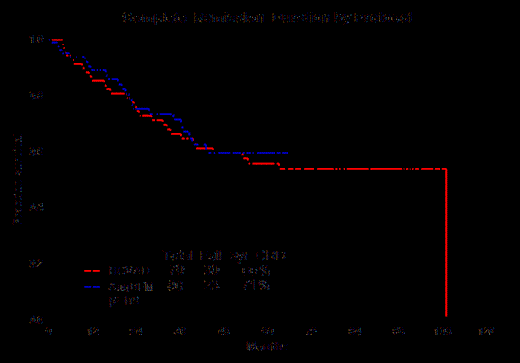Abstract
Pediatric-based therapy of acute lymphoblastic leukemia (ALL) has been proposed as superior treatment for teen-agers and young adults with ALL. Several trials report improved survival rates in young adult ALL patients (pts) when treated with pediatric-based regimens. Augmented Berlin-Frankfurt-Muenster (ABFM) treatment is effective treatment for ALL in adolescents up to age 21. In an attempt to improve cure rates in AYA pts with ALL, we administered ABFM therapy to pts age 12 to 40 in a prospective, single institution trial. Results were then retrospectively compared to the HYPER CVAD regimen, the historical adult ALL regimen used at our institution. 85 pts with de novo Philadelphia chromosome negative ALL have completed at least 6 months of therapy. There are 69 (81%) pts with pre-B ALL and 16 (18%) pts with T-cell ALL/lymphoma. The age range is 13-39 with a median of 21. The median WBC at diagnosis is WBC=14 thousand/microliter (range 0.4-494). 80/85 (94%) pts entered remission (<5% blasts on day 29 marrow morphology). 1 patient died during induction. 61(72%) pts attained remission at day 15 of induction. 29 (22%) did not have morphological remission by day 15 of induction. At the end of induction, 46(58%) pts were minimal residual disease (MRD) negative by flow cytometry (<0.01% blasts). 25(31%) were positive for MRD and 6(7%) were not available or equivocal. By approximately day 84 of treatment, 55(69%) pts were negative for MRD and 13(16%) were positive or suspicious. Toxicities encountered include severe allergy to PEG-asparaginase in 17 (20%) pts, thrombosis in 18 (21%), hyperbilirubinemia grade III-IV in 31 (36%), elevated ALT grade III-IV in 28 (33%), hypofibrinogen grade III-IV in 30 (35%), pancreatitis in 9(11%), and avascular necrosis in 9 (11%). Grade III-IV hepatic toxicity is frequent but resolves within two weeks in almost all pts. For the entire cohort, the estimated 3 year overall survival (OS) is 75% and 3 year complete remission duration (CRD) is 71%. In univariate analysis, negative MRD at day 29 was associated with improved OS and day 84 negative MRD was associated with improved CRD. The presenting WBC was associated with OS and CRD. On multivariate analysis, only WBC over 50k/microliter maintained significance for OS and CRD. In comparing ABFM to HYPER CVAD, there is no significant difference in OS or CRD between the two regimens (fig. 1 and 2). This lack of difference in OS and CRD persists when patients are stratified for age > or </= 21 years, for presenting WBC over 50 thousand, and for MRD at the end of induction. In our hands, pediatric based therapy has significant though tolerable toxicity. Outcomes in AYA pts are similar but not superior to results obtained with historical ALL therapy.


No relevant conflicts of interest to declare.
Author notes
Asterisk with author names denotes non-ASH members.

This feature is available to Subscribers Only
Sign In or Create an Account Close Modal